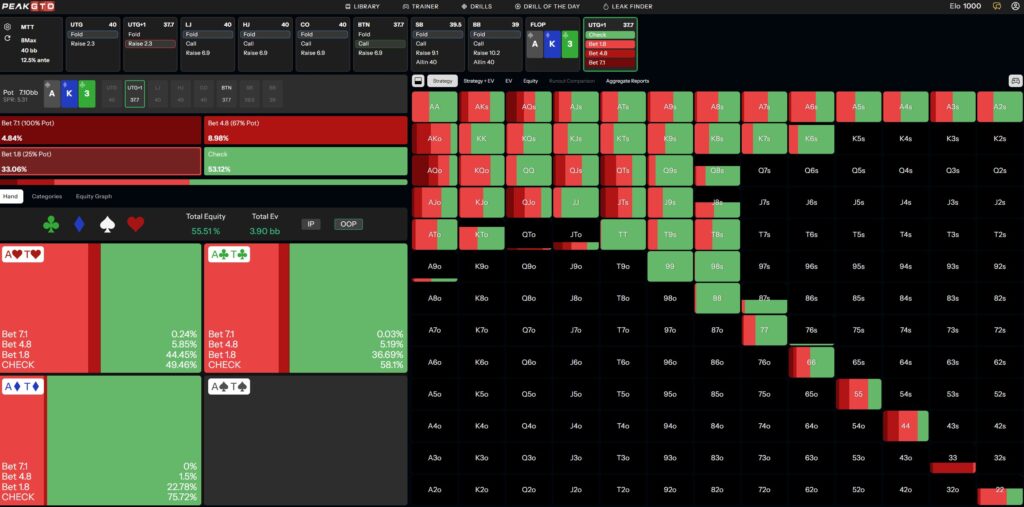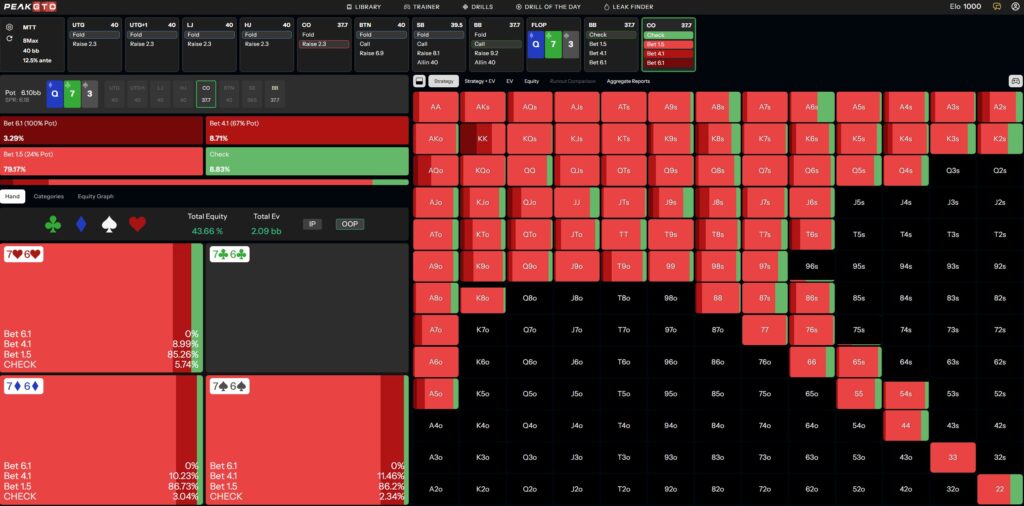Every decision to bet, check, or fold comes down to understanding how your range interacts with the board and how your opponent’s range stacks up against it. The difference between guessing and knowing what to do on the flop is the difference between an average player and a true professional.
In Tournament Masterclass 2.0, Jonathan Little breaks down the complex world of postflop play into a simple, structured system that any serious tournament player can follow.
In this exclusive sneak peek, Jonathan walks through the core theory of flop play, teaching how to categorize your hands, decide when to bet, and use position to your advantage.

Lesson 1: Categorizing Your Hand on the Flop
Jonathan starts by teaching one of the most important and overlooked concepts that not all poker hands are created equal.
Instead of reacting emotionally, “I hit the board!”, professionals approach every flop by categorizing their hand type. This mental framework simplifies decisions, reduces mistakes, and ensures consistency across sessions.
In Tournament Masterclass 2.0, Jonathan defines five core categories for flop play:
- The Nuts (and Near-Nuts) – Hands that can confidently bet for value and stack off. Think flopped sets, straights, or strong two pairs on coordinated boards.
- Strong Hands – Made hands that are often best but vulnerable to future cards, such as top pair/top kicker or an overpair on a wet board.
- Marginal Hands – One-pair hands or medium-strength holdings that do well in small pots but struggle against big aggression.
- Draws – Hands with strong potential (flush draws, open-enders, combo draws). These can bet or check depending on fold equity and stack depth.
- Air – Total misses that rely purely on fold equity.
Once you identify which category your hand belongs to, the rest of the decision-making becomes fairly straightforward:
- Nuts and strong hands typically want to build pots;
- Marginal hands prefer pot control;
- Draws and air can mix in bluffs when conditions are right.
“Every flop is easier when you know what type of hand you have. If you’re guessing whether to bet or check, you probably haven’t categorized correctly.” – Jonathan Little
Lesson 2: When to Bet and How Much

Once you know your hand type, the next step is understanding when to bet and how to size your bets.
Jonathan explains that pros don’t bet just because they have a strong hand, but they bet because their range and the board texture give them the advantage.
For example, when you raise from an early position and the flop comes A♠ K♦ 3♣, that’s your board. You have the range advantage with all the best hands like AK, AA, and KK, while your opponent, who called preflop, often does not. This is a prime spot for a small continuation bet (C-bet), even with air, because your range credibility is so high.
However, when the flop comes 8♠ 7♠ 6♣, that same strategy fails. The board now favors your opponent’s calling range, which is full of suited connectors, pairs, and draws. In these spots, Jonathan advises checking back more often or betting smaller with strong but vulnerable hands.
He also breaks down bet sizing by intent:
- Small bets (25–40% pot) – Used on dry, high-card boards or when applying range pressure.
- Medium bets (50–70%) – For value protection or semi-bluffing with strong equity.
- Large bets (75–100%+) – For polarized situations with the nuts or strong bluffs on draw-heavy textures.
Jonathan emphasizes that bet size should always communicate something coherent about your range, not your hand. Recreational players often bet big when strong and small when weak — a pattern that pros exploit relentlessly.
“Your bet size should match your range advantage, not your emotions. If you’re always betting bigger with the nuts, you’re leaving money on the table.” – Jonathan Little
Lesson 3: Using Position to Maximize EV

If the position was powerful preflop, it’s even more valuable on the flop. Jonathan explains that being in position isn’t just about acting last, but it’s about controlling the pot size, seeing your opponent’s action first, and realizing more equity.
When you’re out of position, your strategy must tighten. Check more often, use smaller bet sizes, and protect your checking range with some strong hands to prevent exploitation. Conversely, when you’re in position, you can mix in more delayed continuation bets and thin value bets.
For example, if you raise from the cutoff and the big blind calls, and the flop comes Q♦ 7♣ 3♠, you can C-bet small at a high frequency. On the same board, you’ll realize less equity out of position and face tougher decisions when raised, therefore, you should be leaning towards betting less often.
Jonathan also points out that players frequently underestimate how much position changes bet sizing dynamics. In position, smaller bets often suffice because you can extract value later; out of position, larger bets can deny equity to your opponent’s wide calling range.
“Position gives you the information advantage so don’t waste it by playing as if you were out of position.” – Jonathan Little
Bringing It All Together
Flop play is where technical understanding becomes tangible. It’s the point where theory, math, and intuition meet and where small edges compound into tournament-changing results.
In Tournament Masterclass 2.0, Jonathan Little teaches players not just to memorize solutions, but to think in frameworks:
- Categorize your hand correctly.
- Understand when your range has the advantage.
- Use position and sizing to control outcomes.
Mastering these fundamentals turns guesswork into precision, helping you build pots confidently, protect your equity, and stay a step ahead of the field on every board.
The Flop section of Tournament Masterclass 2.0 is where you’ll start to feel poker strategy “click.” You’ll see how the best players think across ranges, why their decisions seem effortless, and how you can apply the same clarity in your own game.
Stay tuned for the next sneak peek in this series, where we’ll dive into Turn and River strategy, learning how to convert equity into maximum profit and close out hands like a pro.



